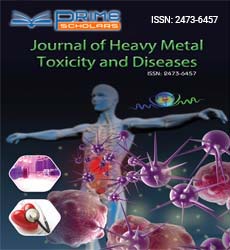Commentry - (2023) Volume 8, Issue 6
Unveiling the Culprits: Industrial Sources of Heavy Metal Contamination
Sha Jhin*
Department of Science, Henan University, China
*Correspondence:
Sha Jhin,
Department of Science, Henan University,
China,
Email:
Received: 29-Nov-2023, Manuscript No. ipjhmct-24-18981;
Editor assigned: 01-Dec-2023, Pre QC No. ipjhmct-24-18981 (PQ);
Reviewed: 15-Dec-2023, QC No. ipjhmct-24-18981;
Revised: 20-Dec-2023, Manuscript No. ipjhmct-24-18981 (R);
Published:
27-Dec-2023, DOI: 10.21767/2473-6457.23.6.59
Description
Heavy metal contamination, a persistent environmental
challenge, poses significant threats to ecosystems and human
health. Among the diverse sources of heavy metals, industrial
activities stand out as major contributors to environmental
pollution. This article explores the various industrial sources of
heavy metal contamination, shedding light on the processes
and activities that release these toxic substances into the
environment. Mining activities are prominent contributors
to heavy metal contamination. Extraction and processing of
minerals, including metals like lead, mercury, cadmium, and
copper, release substantial amounts of these elements into
the environment. Runoff from mining sites can transport heavy
metals into nearby water bodies, affecting aquatic ecosystems
and posing risks to human communities residing in the vicinity.
Metal smelting and refining operations are notorious for
releasing heavy metals into the air, soil, and water. During the
smelting process, ores are heated to extract metals, emitting
fumes containing heavy metal particles. These particles can
settle on soil and water surfaces, contaminating agricultural
lands and aquatic ecosystems. Historical smelting activities
have left a lasting legacy of heavy metal pollution in many
regions. Industrial facilities generate wastewater containing
heavy metals through various processes such as metal plating,
electroplating, and chemical manufacturing. When untreated
or improperly treated, these effluents can contaminate local
water bodies. Industrial discharges are a significant source of
heavy metal contamination in rivers, lakes, and coastal areas,
impacting aquatic life and potentially entering the human
food chain through seafood consumption. The combustion of
coal, a widespread energy source, is a significant contributor
to heavy metal contamination. Coal naturally contains trace
elements like mercury, and combustion releases these metals
into the atmosphere. Mercury, in particular, can be emitted in
gaseous form and eventually deposit into water bodies. This
process, known as atmospheric deposition, contributes to
mercury contamination in aquatic ecosystems. Construction
and demolition activities can release heavy metals present in
construction materials into the environment. Materials like
paints, coatings, and treated wood may contain lead, cadmium,
or chromium. As these materials deteriorate or are disposed of
improperly, heavy metals can leach into soils and potentially
contaminate groundwater. The recycling of electronic waste, such
as old computers, smartphones, and other electronic devices,
can release heavy metals into the environment. Circuit boards,
batteries, and other electronic components often contain metals
like lead, mercury, and cadmium. Improper disposal and informal
recycling methods in some regions contribute to soil and water
contamination with these toxic metals. Industries involved in
chemical manufacturing and processing may use heavy metals
as catalysts or raw materials. Effluents from these processes can
contain elevated levels of heavy metals. Disposal of industrial
byproducts or improper storage of hazardous waste can result in
soil and water contamination, impacting ecosystems and posing
risks to human health. Certain types of power plants, particularly
those burning fossil fuels or biomass, can release heavy metals
into the environment. Coal-fired power plants, in particular, emit
metals like mercury, lead, and cadmium into the air through
the combustion of coal. Efforts to reduce emissions from power
plants aim to mitigate heavy metal contamination associated
with energy production. The manufacturing of agricultural
chemicals, including pesticides and fertilizers, involves the use of
heavy metals. Some pesticides may contain metals like arsenic
or mercury. Runoff from agricultural fields treated with these
chemicals can carry heavy metals into water bodies, impacting
aquatic ecosystems and potentially entering the food chain.
Industrial processes related to automobile manufacturing and
the disposal of end-of-life vehicles contribute to heavy metal
contamination.
Acknowledgement
None.
Conflict Of Interest
The author states there is no conflict of interest.
Citation: Jhin S (2023) Unveiling the Culprits: Industrial Sources of Heavy Metal Contamination. J Heavy Met Toxicity Dis. 08:59.
Copyright: © 2023 Jhin S. This is an open-access article distributed under the terms of the Creative Commons Attribution License, which permits unrestricted use, distribution, and reproduction in any medium, provided the original author and source are credited.

